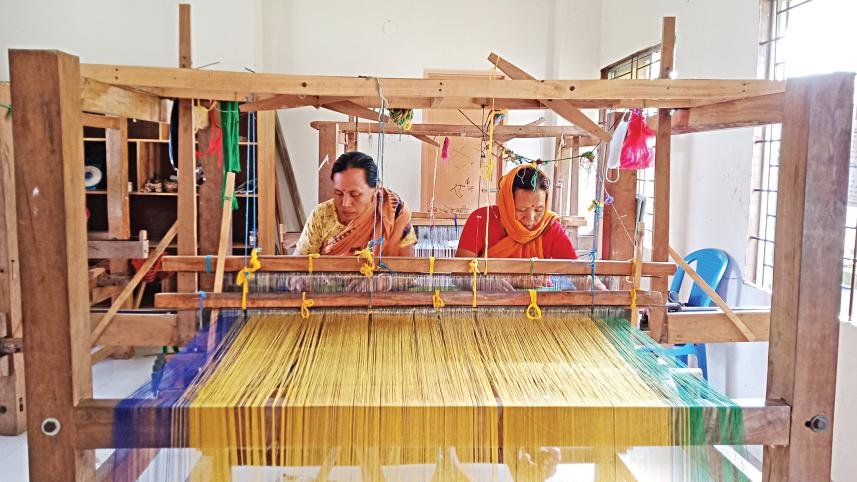Weaving for Eid: Manipuri artisans strive despite odds

In the bustling areas of Kamalganj and Srimangal in Moulvibazar, along with Sylhet city, weavers from the Manipuri community are tirelessly preparing for Eid, crafting their renowned traditional saris and other products.
While hopes for substantial profits have dimmed slightly, these artisans remain steadfast in their commitment to preserving the age-old craft. Besides, they are getting slightly better returns for their efforts this year.
The resilience of these artisans reflects a deep connection to their cultural heritage as they navigate the challenges of a changing market.
Also, the market is being flooded with counterfeit Manipuri saris, and they are losing control of the industry.
The Manipuri community resides in about 15 villages in Kamalganj, with around 15,000 of them spread across this area as well as parts of Srimangal and Sylhet city.
Over the years, handlooms have become a staple in nearly every household, thanks to support from NGOs and bank loans. Manipuri artisans typically earn between Tk 10,000 and Tk 12,000 per month, though incomes have steadily declined in recent times.
During a visit to villages such as Kandigaon, Majhergaon, Bandargaon, Ghoramara, Alinagar, and Madhabpur, it was seen that women were weaving saris in between household chores.
Shantona Singha, a second-year honours student, recalled the ups and downs of the industry.
"In the late '90s, skilled artisans began losing interest. But by the early 2000s, the industry saw a revival due to increased demand for Manipuri saris.
The demand is especially high ahead of Eid," she said.
At the Manipuri Cultural Academy in Adampur Bazar, women were seen diligently weaving saris and other textiles.
Sudhamoy Sharma, supervisor of the academy's clothing manufacturing and sales centre, said they receive orders from across the country, including Chattogram, Rajshahi, Dhaka, and Brahmanbaria.
"This year, we are experiencing higher demand and better prices, though keeping up with the orders remains a challenge," Sharma added.
The demand for Manipuri clothes is driven by their authenticity. Manipuri women weave saris with unique designs and patterns.
Rani Singh, a young worker at the academy, noted that prices for Manipuri saris range from Tk 5,000 to Tk 20,000, depending on design and quality. However, rising costs of yarn and labour have strained profitability.
Lubna Akhtar, a local entrepreneur, said she installed 50 handlooms, with 45 currently operational. But even with higher production, profit margins remain thin.
Sufia Akhtar, a weaver from Bandargaon village, said every household in the Manipuri community now has a loom.
"We can complete a sari in two to three days. But with Eid approaching, the profit from each sari has decreased," she added.
"We sell them for Tk 4,000 to Tk 5,000, which is a modest sum for the hard work involved."
Suniti Singh from Majhergaon village said sales have slowed, and the market is inundated with imitation Manipuri saris.
Sakhawat Mia, a local trader, said that as middlemen take their cut, it leads to losses for weavers.
Kamalganj Upazila Nirbahi Officer Makhon Chandra Sutradhar said this industry is integral to Kamalganj.
"So, we must work to ensure its sustainability," he added.
Dr Sanjeeb Meetoi, co-director of Inafi Manipuri Handicraft (a wholesaler), said that while the demand for Manipuri clothing is on the rise and the industry has gained international recognition, supply issues persist.
"We rely on imported materials like yarn and dyes from China, creating a bottleneck in production. Despite these challenges, we are hopeful for a prosperous Eid season," he added.
Rabi Singha Rajesh, former member secretary of the Manipuri Cultural Academy, said that approximately 10 to 20 percent of the Manipuri community has abandoned the profession due to a lack of capital.
"But this year, Eid demand is higher than ever. Around 35 percent of our annual sales happen during this time," he added.
As such, people involved with the Manipuri weaving industry have called on the government to facilitate low-interest loans and simplify the loan process to support their livelihoods.




 For all latest news, follow The Daily Star's Google News channel.
For all latest news, follow The Daily Star's Google News channel.
Comments